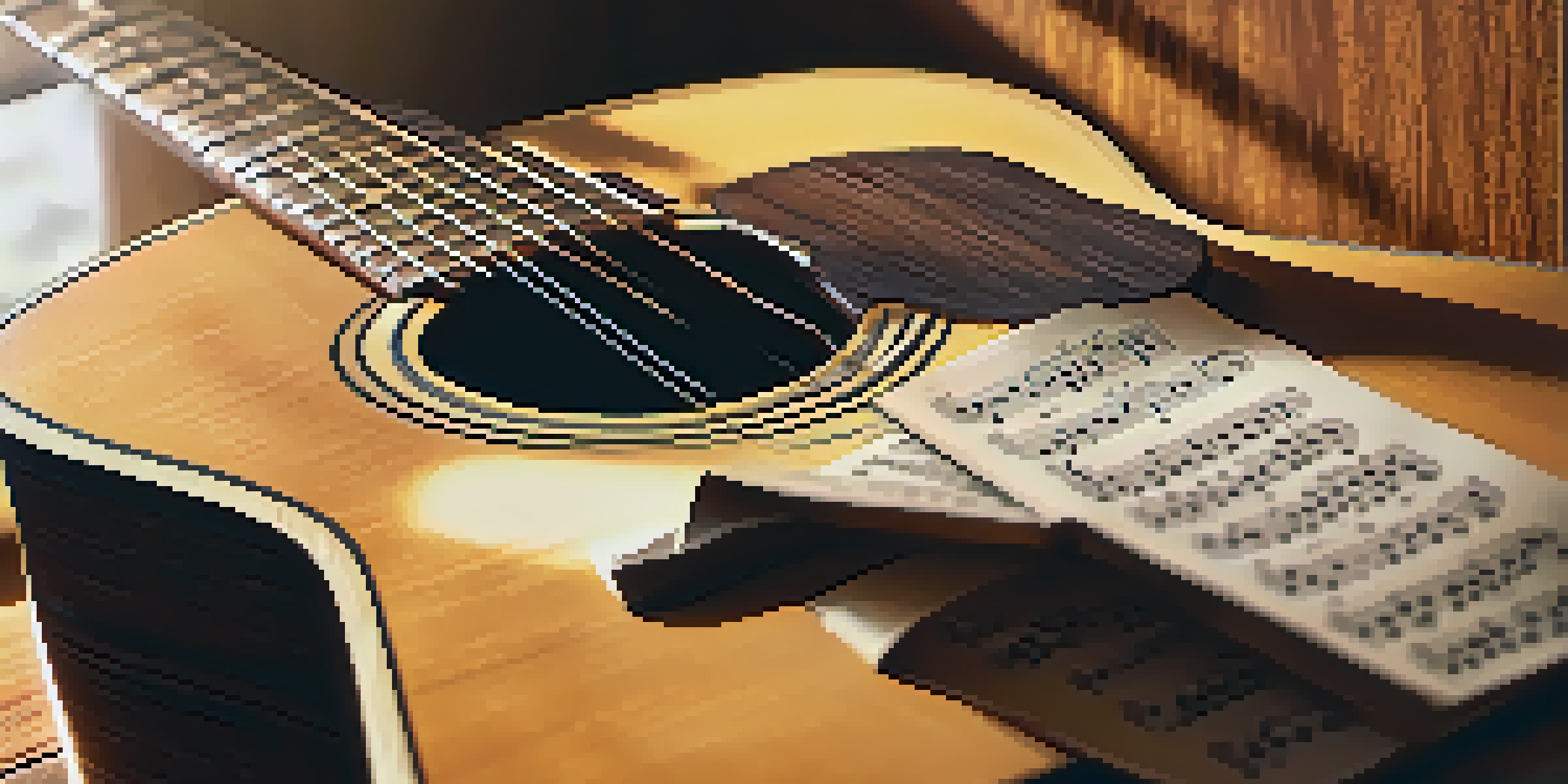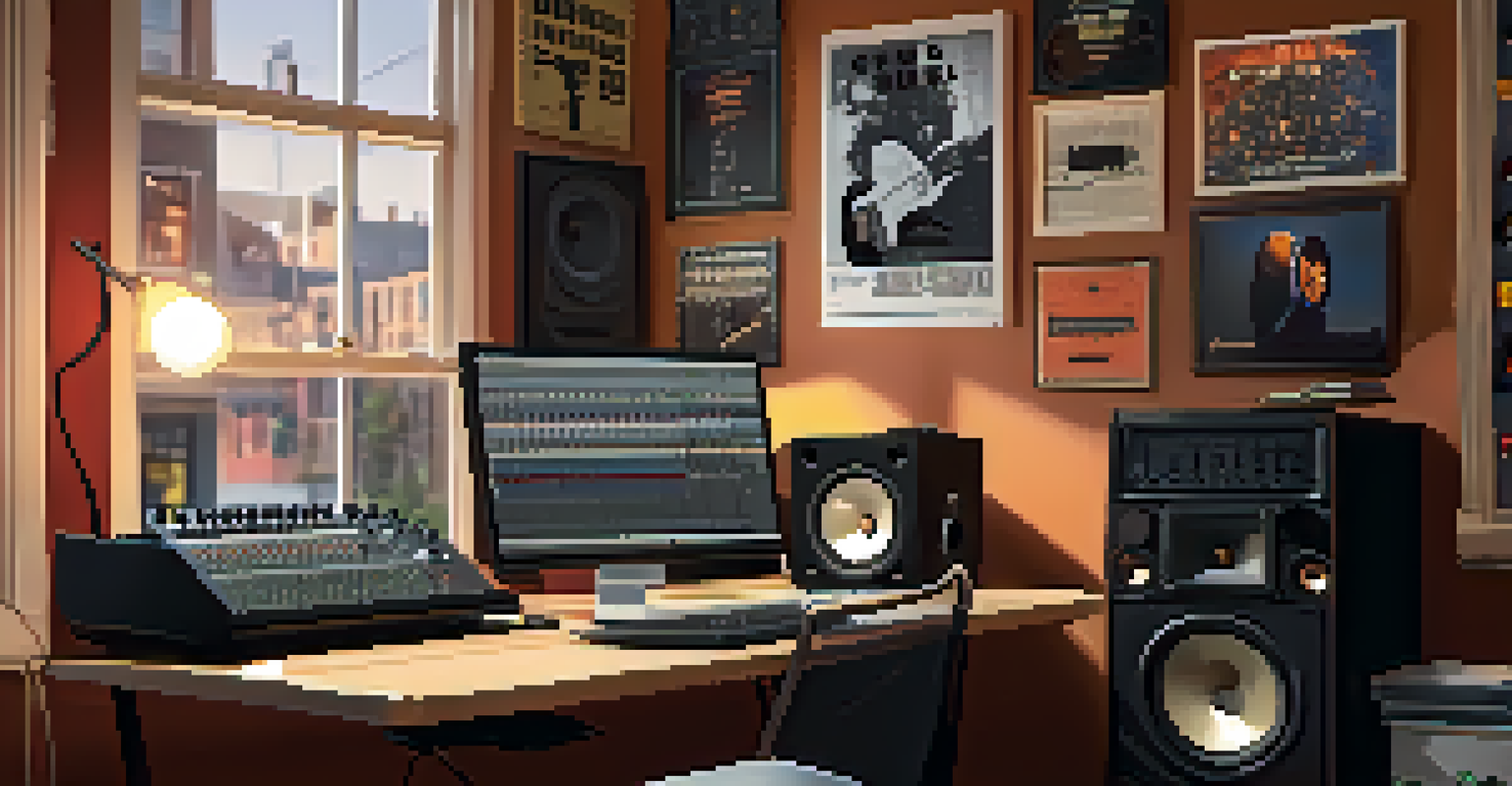Transcribing Guitar Solos: Tips for Beginners and Pros

Understanding the Basics of Transcribing Guitar Solos
Transcribing guitar solos is the process of listening to a solo and writing it down, whether in tablature or standard notation. For beginners, this might seem daunting, but it's a valuable skill that enhances your ear and playing technique. Think of it as learning a new language; the more you practice, the more fluent you become.
Music is the shorthand of emotion.
Regardless of your skill level, transcribing helps you identify phrasing, techniques, and nuances that can be easily overlooked. By breaking down a solo note by note, you not only learn the song but also gain insight into the guitarist's style and approach. This deeper understanding can significantly improve your own playing and creativity.
As you embark on your transcribing journey, remember that patience is key. Start with simpler solos, gradually increasing the complexity as you become more comfortable. Each successful transcription builds your confidence and reinforces your musical understanding.
Choosing the Right Gear for Transcribing
Having the right tools can make the transcription process smoother and more enjoyable. A quality pair of headphones is essential; they help you isolate the guitar parts and catch subtle nuances in the playing. Consider investing in a good digital audio workstation (DAW) or transcription software that allows you to slow down tracks without altering the pitch.

Additionally, a guitar tuner and a metronome can be incredibly helpful. As you transcribe, use the tuner to ensure you’re hitting the right notes and the metronome to keep your timing accurate. This equipment can transform your transcription experience from frustrating to fulfilling.
Transcribing Enhances Your Skills
Transcribing guitar solos improves your ear and playing technique, allowing you to understand the guitarist's style and nuances.
Lastly, don’t underestimate the value of a notebook or transcription app. Keeping your notes organized will make it easier to reference your work later. Whether you prefer digital or traditional methods, find what works best for your workflow.
Listening Techniques for Effective Transcription
Listening to a solo can sometimes feel overwhelming, especially when you're trying to catch every note. A great approach is to break the solo into small sections or phrases. Focus on one phrase at a time, playing it repeatedly until you feel comfortable transcribing it. This method takes the pressure off and allows you to concentrate on the details.
The more you practice, the better you get, the more freedom you have to create.
Another useful technique is to listen to the solo at a slower speed. Many transcription software options allow you to slow down the playback without altering the pitch. This makes it easier to catch fast runs or intricate techniques that might be missed at normal speed.
Finally, don’t be afraid to use your guitar as a tool. Play along with the recording as you listen, matching the notes you hear. This hands-on approach reinforces your understanding and helps you internalize the solo, making transcription feel more like a conversation with the music.
Transcribing Techniques: What to Focus On
When transcribing, pay close attention to the techniques used by the guitarist, such as bends, slides, and hammer-ons. These techniques add character and emotion to a solo, making it uniquely expressive. By accurately transcribing these details, you’ll not only learn the notes but also the feel of the solo.
Also, consider the dynamics and phrasing of the solo. Notice how the guitarist builds tension or releases it through volume changes or rhythmic placement. Understanding these elements will give your own playing more depth and nuance, as you'll be able to convey similar emotions in your performances.
Use Tools for Effective Transcribing
Having quality headphones, transcription software, and a tuner can significantly enhance your transcription experience.
Lastly, don't forget about the context of the solo within the song. Recognizing how the solo interacts with the rhythm section can provide insight into its structure and purpose. This holistic view enhances your understanding and appreciation of the music as a whole.
Transcribing Solos by Ear vs. Using Software
Transcribing by ear is a traditional method that helps develop your musical skills, while software can provide assistance in challenging areas. Many musicians prefer the ear method because it strengthens their ability to recognize notes, intervals, and chord changes. It’s a bit like learning to ride a bike; you might wobble at first, but soon you’ll find your balance.
On the other hand, using software can speed up the process and reduce frustration, especially for beginners tackling complex solos. Programs that allow you to slow down music or loop specific sections can be invaluable learning tools. However, it's essential to not rely solely on technology; balance it with ear training to ensure comprehensive skill development.
Ultimately, the best approach might be a combination of both methods. Start by attempting to transcribe by ear, and when you hit a roadblock, use software to assist you. This blend of techniques can create a robust learning experience that caters to your specific needs.
Common Mistakes to Avoid When Transcribing
One common mistake many beginners make is trying to transcribe solos that are too complex for their current skill level. While it’s great to challenge yourself, starting with a solo that’s overly ambitious can lead to frustration and discouragement. Instead, choose pieces that are slightly above your current abilities and work your way up gradually.
Another pitfall is neglecting to take breaks during the transcription process. Your ears can become fatigued, making it harder to distinguish notes and nuances. Taking short breaks can refresh your focus, ensuring you maintain accuracy and clarity in your transcription work.
Practice Regularly for Mastery
Consistently practicing transcribed solos solidifies your skills and encourages creative applications in your own playing.
Finally, avoid the temptation to rush through the transcription. Quality is more important than speed. Take your time to ensure you capture every detail correctly; this patience will pay off in your overall musical development.
Putting It All Together: Practice Makes Perfect
Once you’ve transcribed a solo, it’s crucial to practice it regularly. Playing the solo in its entirety helps reinforce what you’ve learned and improves your muscle memory. This practice not only solidifies your transcription skills but also enhances your overall playing ability.
As you become more comfortable, try to incorporate elements of the solo into your own playing. This might mean adding some of the techniques you learned into your own improvisations or composing new solos inspired by what you’ve transcribed. This creative application can lead to exciting musical discoveries.

Finally, make it a goal to transcribe and learn new solos regularly. This consistent practice will not only improve your ear and technique but also expand your musical vocabulary. The more you transcribe, the more confident and skilled you'll become as a guitarist.